| --Flyhawk |
Renault FT-17 |
|||
Kit
#'s: FH 3000 & FH 3001 |
Preview
by Marc Mercier |
|||
| --Flyhawk |
Renault FT-17 |
|||
Kit
#'s: FH 3000 & FH 3001 |
Preview
by Marc Mercier |
|||
These
two kits are the first armour subjects Flyhawk brought on the market.
Since they have about 95% commonality, I'll discuss them together
here. They
could be equipped with either a Hotchkiss 8mm machine gun or the Puteaux
37mm with its telescopic sight, both weapon systems being included
in the kits. |
||
Each Flyhawk box contains two models of the same tank, comprising two identical large sprues and four smaller bags (containing for instance loose parts like the turret). It also packs a "Dragon" style goodies card carrying one large decal sheet and two identical PE sheets. The instruction sheet is printed on good quality gloss paper containing clear line drawings and full colour painting schemes (with paint references for Tamiya and Mr. Hobby). Using state of the art slide moulding technology, Flyhawk provides us with an one piece turret and fuselage with extremely sharp detail all around. Although the holes for the hatches are open, the hatches themselves are designed for the closed position. However, it should be easy to adapt them or make new ones should you prefer to open them up. Except for the armament, there is no interior detail however. The surface textures are superb, raised or recessed as appropriate. Even
the underside of the fuselage is nicely reproduced. |
||
The
quality of the casts is really high, with very sharp details and light-years
ahead compared with the older RPM FT-17. Just take a look at these
pictures to compare both fuselages and turret.
|
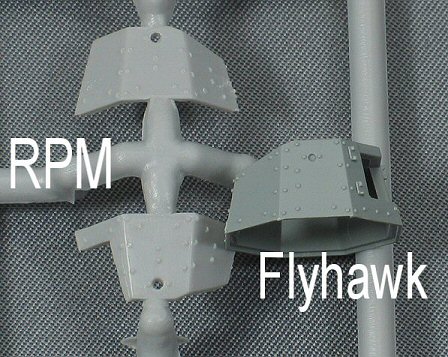 |
|
I'm quite impressed by the injection moulded tracks provided by Flyhawk, which are superb. Just compare these with the vinyl ones provided by RPM. In fact, using an original and clever breakdown, the whole suspension consist of only 6 parts, but still has enough details to satisfy the most demanding of modellers. |
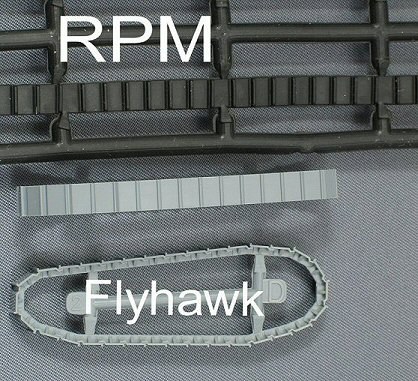 |
|
Both
versions have a common chassis and their kits contain two kinds of
idlers: the so-called wooden version on the main sprue and the steel
ones on a separate sprue (B), which, according to the instruction
sheet, aren't used for the build of the riveted turret FT. |
||
At
first view, I thought Sprue A (the big one) was identical for both
versions. However on closer inspection, I discover part 24 (the rear
turret hatches) has a different shape according to the version (see
below). However, I'd like to note that this part it is not used for
the build of the riveted turret, only for the cast one. |
||
A small PE sheet is provided of which about half the parts are needed for building the kit, the other half can be used to substitute thicker injection moulded pieces. The cast turret one has more parts on it; besides the frame for the gun, you also get the oval Renault brand insignia (see PE-8). This was only present on the tanks manufactured by Renault itself, the tanks assembled at the subcontractors or the copies made in other countries, obviously lacking this feature. However, I found a picture (see below) of a riveted tank carrying this oval insignia too, so I have no clue why it was left out by Flyhawk on this version. |
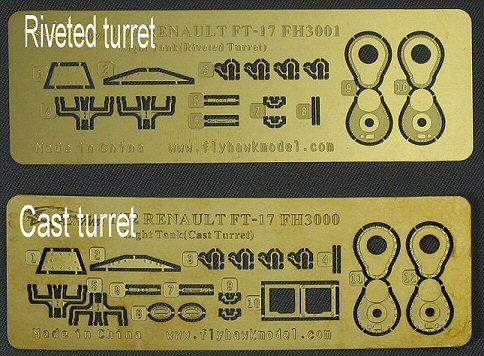 |
|
| I checked the dimensions of the fuselage and the tracks against the drawings in "AFV Plans 1914-1938 Armored Fighting Vehicles" by George Bradford, suitable scaled down to 1/72 and, keeping the limitations of my method in mind, I found them well within limits. (see below) | ||
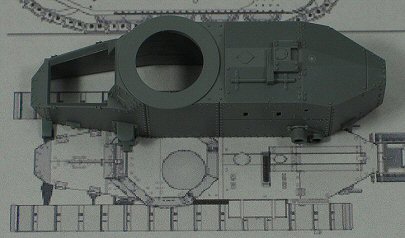 |
||
Decals and painting schemes The same decal sheet is present in both kits. It gives enough decals for a total of 8 tanks, of which 2 are the riveted version and 6 the cast one. The decals are in register. However, the print quality seems inferior compared with those provided by Revell or Dragon. On looking closely one can see the print dots, certainly in the darker colours like dark blue or black. See below. |
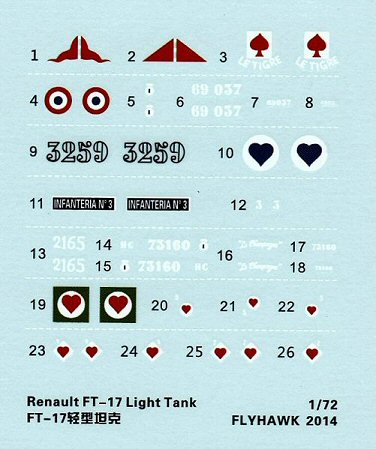 |
|
| However, see picture below right, there are no captions explaining the origin or unit of the different tanks provided in the cast version (they only got numbered I to VI), which is a bit of a disappointment. On the left however, the two tanks on the riveted version colour sheet are provided with captions. | ||
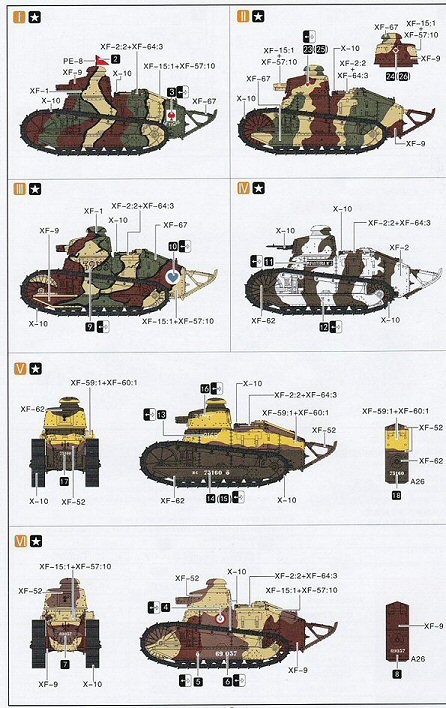 |
||
I'm not a FT-17 specialist, so I tried to find out something more about the origins of some of the 6 versions included in the cast turret kit. When surfing the net I discovered this black-white picture (left) of cast turret tank Nr. IV at this site http://home.comcast.net/~dapena/tanks/cipri.htm. Apparently this tank was used by the Spanish forces in Morocco in 1922. However, this version is presented by Flyhawk as being in a brown/white camouflage pattern, but when looking at the original tank and keeping the terrain on which it was used in mind, I have a strong suspicion that the white should be more of a sand colour. |
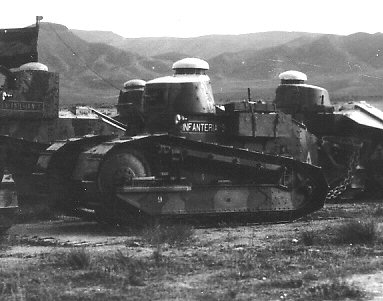 |
|
I didn't find an exact match of cast turret tank Nr. I (le Tigre). The closest I came is this picture (source http://atf40.forumculture.net/t289p45-numerotation-des-chars-ft) where the similarity of the name is quite striking, but the rest doesn't seem to match. The card symbol above the name is a Spade and not Hearts as proposed by Flyhawk. The number on the side, that can be vaguely seen on the picture is also missing on the decal sheet. Even the camouflage pattern is different. Is this decal sheet for Tigre then correct? |
||
| Conclusion References Addendum (10 December 2020 - Al Magnus):
|
||
Back to Flyhawk List |
Back to Home Page |
Article Last Updated: |